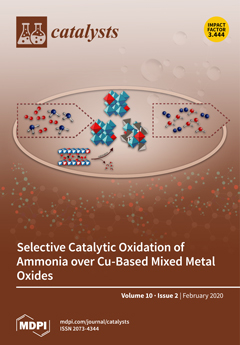Dry reforming of methane (DRM) was studied in the light of Ni supported on 8%PO
4 + ZrO
2 catalysts. Cerium was used to modify the Ni active metal. Different percentage loadings of Ce (1%, 1.5%, 2%, 2.5%, 3%, and 5%) were tested.
[...] Read more.
Dry reforming of methane (DRM) was studied in the light of Ni supported on 8%PO
4 + ZrO
2 catalysts. Cerium was used to modify the Ni active metal. Different percentage loadings of Ce (1%, 1.5%, 2%, 2.5%, 3%, and 5%) were tested. The wet incipient impregnation method was used for the preparation of all catalysts. The catalysts were activated at 700 °C for ½ h. The reactions were performed at 800 °C using a gas hourly space velocity of 28,000 mL (h·gcat)
−1. X-ray diffraction (XRD), N
2 physisorption, hydrogen temperature programmed reduction (H
2-TPR), temperature programmed oxidation (TPO), temperature programmed desorption (TPD), and thermogravimetric analysis (TGA) were used for characterizing the catalysts. The TGA analysis depicted minor amounts of carbon deposition. The CO
2-TPD results showed that Ce enhanced the basicity of the catalysts. The 3% Ce loading possessed the highest surface area, the largest pore volume, and the greatest pore diameter. All the promoted catalysts enhanced the conversions of CH
4 and CO
2. Among the promoted catalysts tested, the 10Ni + 3%Ce/8%PO
4 + ZrO
2 catalyst system operated at 1 bar and at 800 °C gave the highest conversions of CH
4 (95%) and CO
2 (96%). The stability profile of Cerium-modified catalysts (10%Ni/8%PO
4 + ZrO
2) depicted steady CH
4 and CO
2 conversions during the 7.5 h time on stream.
Full article





